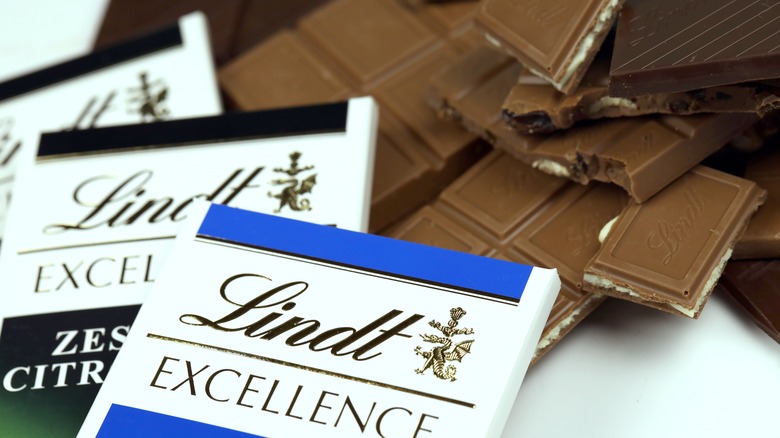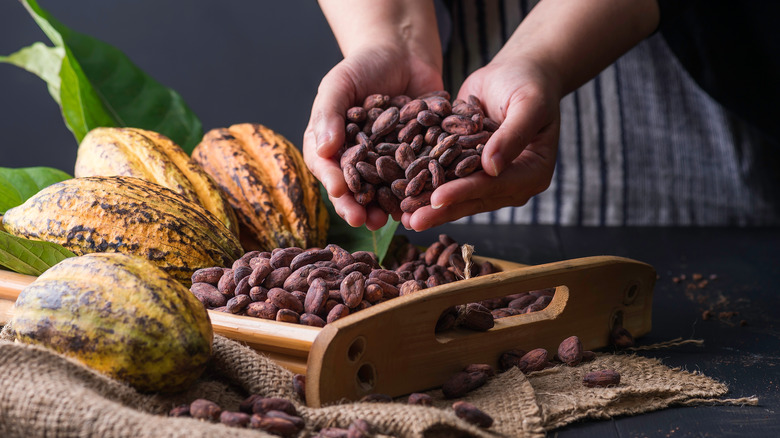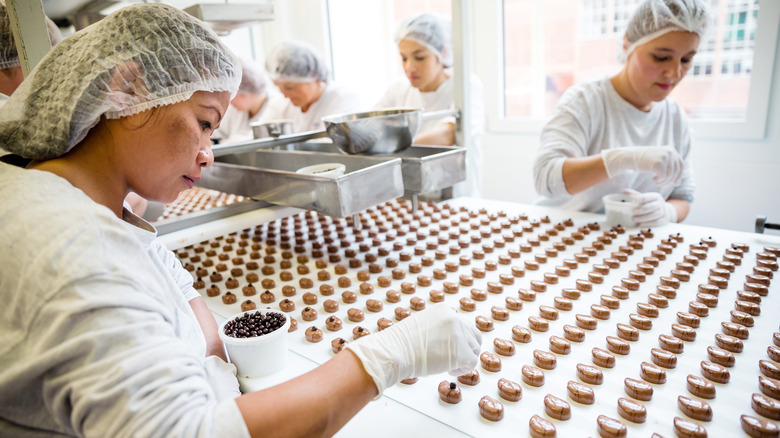Is Lindt A Bean-To-Bar Chocolate Company?
You may be familiar with farm-to-table dining and bean-to-cup coffee, both of which advocate a return-to-nature approach to what we eat and drink. But they aren't the only earthy catchphrases permeating the world of gastronomy these days. With the growing number of conscientious consumers across the globe, it's no surprise that chocolate now enters the conversation and that premium chocolate brands are tentatively making bean-to-bar commitments.
Controlling a supply chain from agricultural fields to final production factories is a way to guarantee transparency and accountability on almost every level. It benefits farmers, field and factory workers, roasters, processors, chocolatiers, consumers, and ultimately, the environment, explains Perfect Grind Daily. But it's not an easy commitment to make, and few in the world of chocolate go all-out to embrace the concept, at least for now.
In fact, CEO Dieter Weisskopf of Lindt & Sprüngli, a renowned leader in the premium chocolate segment, acknowledges the challenges and complexities involved, according to the Moodie Davitt Report. He stresses the importance of directly addressing issues in order to achieve sustainability, which the company began doing decades ago through its in-house farming program.
But has Lindt been successful, and is it truly a bean-to-bar pioneer amongst its chocolate-making peers? That appears to have a "yes and yes" answer – and here's how it works.
A committed farming program
Lindt & Sprüngli, the Swiss-based makers of popular morsels such as Lindor truffles, Excellence chocolate bars, Ghirardelli squares, Hofbauer pralines, and the playful Gold Bunnies and chocolate umbrellas, started down the path to sustainability and traceable cocoa supply chains in the mid-2000s, explains the company. The bean-to-bar production method it now consistently employs got a serious boost after the launch of the Lindt & Sprüngli Farming Programme in 2008, partially funded by the Lindt Cocoa Foundation, according to ConfectionaryNews. The program facilitates the improvement of living and working conditions for local cacao farmers, while also guaranteeing that raw-material acquisition methods contribute to sustainable agriculture.
The farming program invests in premium bean quality, technology, processing, and final production at in-house cocoa-mass factories throughout Europe and the U.S. Every step of the chocolate-making takes place within the standards and oversight of Lindt, with a heavy focus on quality and farmer training. This approach broadens the knowledge and skills of farmers, who learn how to increase their yields and adopt good farming practices, as noted in a company video.
In turn, Lindt ends up with premium chocolate, consistent access to high-quality cocoa beans, and hopefully, the satisfaction of global responsibility. By 2020, it had reached its goal of 100% cacao bean traceability through the Farming Programme, notes the Moodie Davitt Report. Though the program began in Ghana, it now operates in all the Lindt and Sprüngli cacao-bean countries of origin.
Step by step from bean to bar
A YouTube video produced by Lindt Chocolate World highlights the farming program and bean-to-bar process, detailing how sustainability and traceability efforts evolve and culminate in the end product. Lindt basically follows a multi-step process that begins after local pickers harvest the beans, explains Lindt. Harvesting, fermentation, and drying of the beans takes place in the country of origin. At that point, the beans in their raw form, which grow on Theobroma cacao trees, are technically known in the industry as "cacao" beans explains WebMD, only becoming "cocoa" after processing.
On the way to cocoa transformation, and eventual chocolate designation, the cacao beans have a long journey. Adhering to stringent requirements for identification and quality control, verified by accompanying traceability certificates, the beans arrive at Lindt factories. From there, they undergo infrared cleaning treatments before cracking and de-shelling to obtain the cocoa fragments known as "nibs." They then enter elaborate roasting, crushing, and grinding processes to create the desired cocoa mass.
After mixing with other creamy, buttery ingredients, the cocoa mass finally becomes chocolate. All that's left now in the bean-to-bar transformation is the "conching," a process invented by Rodolphe Lindt in 1979 that transforms brittle surfaces into smooth-melting chocolate.
Lindt & Sprüngli continues its devotion to the bean-to-bar concept, with even loftier goals set for 2025 – including plans to obtain all related cocoa products through sustainable methods, per the Moodie Davitt Report.


